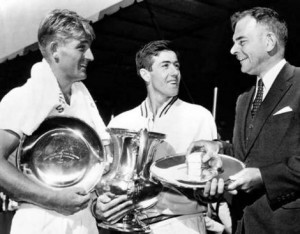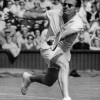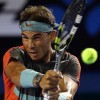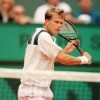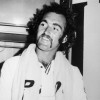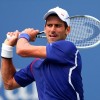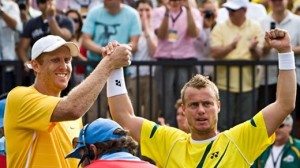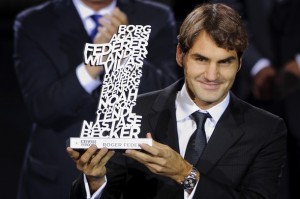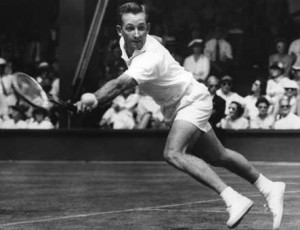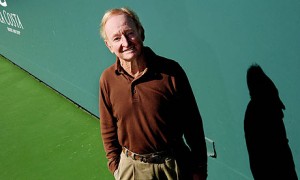There is a common misunderstanding in tennis with regard to the career of Rod Laver. The left-handed Australian legend is the only man to win the Grand Slam of tennis (winning all four major singles titles in a calendar year) twice. He first achieved the feat in 1962 as an amateur in the amateur era of tennis and then again in 1969 in the “Open Era” open to pros and amateurs.
After Laver won the Grand Slam in 1962, he turned professional and was thus not allowed play the Grand Slams until they became “open” to pros at the 1968 French Open. Many people have said that if pros were always allowed to play the Grand Slams from 1963 to 1968, or if the Open Era had started earlier and Laver would be allowed to play Grand Slams between 1963 and 1967, he may have won 20 or more major titles, not just the 11 that he did accrue.
However, when Laver won his 1962 Grand Slam, he was merely the best “amateur” player in the world, not the world’s best player, as players who turned pro before him, like Ken Rosewall, Lew Hoad and Pancho Gonzales, for example, were still better than him at the time.
The following is an excerpt from the book “The Pros: The Forgotten Era of Tennis” by Peter Underwood (for sale and download here: https://a.co/d/02g6w9tI) that discussed Laver’s rude awakening to professional tennis and how he was immediately reminded that he was not the best tennis player in the world at that time.
So it was that on January 5, 1963, in Lew’s hometown of Sydney, one of Hoad’s most fervent admirers came face to face with his boyhood idol. Laver described it this way: ‘Lew had been training for weeks to get ready for the match and right away he made me understand that all the pros jealously defend their reputations.’ Then Rod sharpens this statement with a graphic image: ‘The whole pro group descend on a newcomer like eagles on lambs back home in central Queensland.’
For Laver, this first outing as pro brought mixed news. The good part was that the tennis was great. It was four tough sets, and Laver played well, had his chances, and lost 8–6 in the final set. Further, Laver said that he ‘enjoyed that match more than any I had played in years’. So, he thought, had the big crowd. Ten thousand had come out to watch! On this occasion, the two were neither lepers nor trained seals, but a pair of tennis legends, giving their all. Even the papers, notoriously anti-pro, raved about the match, saying that after years of dullness and division tennis had once more become exciting.
And the bad news?
“Lew and I played until after 11 pm,” said Laver, “and by the time I got to bed … it was 3 am. I woke about noon and at 2 pm I had to go out [against] Rosewall. It was tough all right.”
Laver, feeling stiff and let down after lifting himself for Hoad, was no match for the Pro Champion. Without Hoad’s bravura, Rosewall, the delicate surgeon, took him apart. This time it was straight sets, and took less than an hour.
After the match, all he could say to the press was: “Playing against Ken is like hitting against a brick wall.” Later, Rod said that when he played Hoad for the first time he saw that he was up against the best player he’d ever faced. Then it was Rosewall — who was ‘a lot better’ than Hoad … Then everything got worse.
Laver put it this way:
Lew beat me in eight straight matches after that, and Ken did it in eleven out of thirteen. On the high level of the game, it was as though my tennis education was just beginning. The difference between pro and amateur tennis was so great it took me months to settle down. I felt the pressure … [of being] the top amateur, the man who had equalled Budge’s Grand Slam, and there was a psychological barrier to break through that the pros had created … On some occasions the ease with which they beat me, the constant travelling, and hard matches night after night … made me feel like quitting.
“The Pros” (available here via Amazon: https://www.amazon.com/Pros-Forgotten-Era-Tennis/dp/1937559912/ref=sr_1_1?keywords=The+Pros+Peter+Underwood&qid=1574131803&sr=8-1) describes the era through the stories of eight great tennis champions – Bill Tilden, Ellsworth Vines, Don Budge, Bobby Riggs, Jack Kramer, Pancho Gonzales, Ken Rosewall and Rod Laver – who dominated the pro arenas beginning in 1930 through to the start of the “Open Era” in 1968. Author Peter Underwood explains why these celebrated champions were forced into what was often called a traveling circus, and where these sporting outcasts played each other during long and rather tatty tours all over the world, far from the cushy confines of what was then the amateur game at Wimbledon, Forest Hills and Roland Garros.



